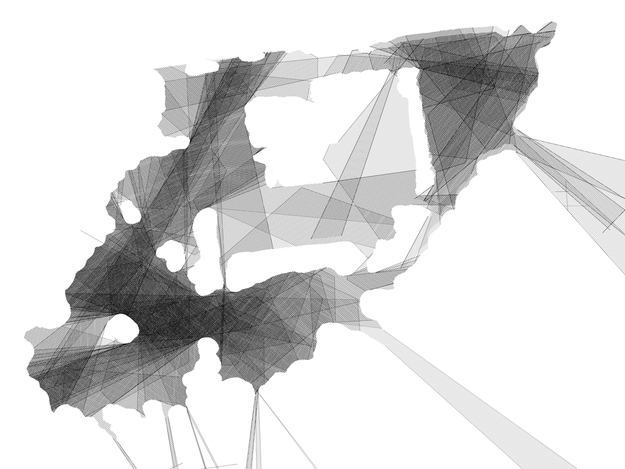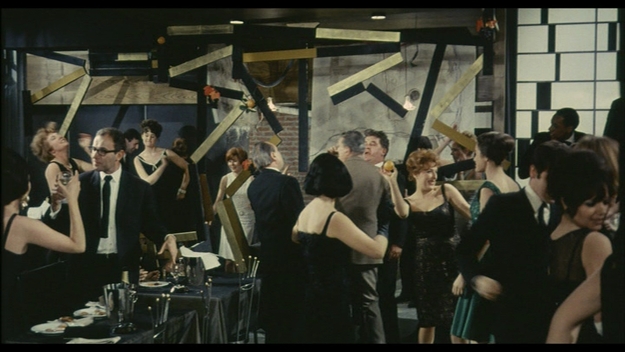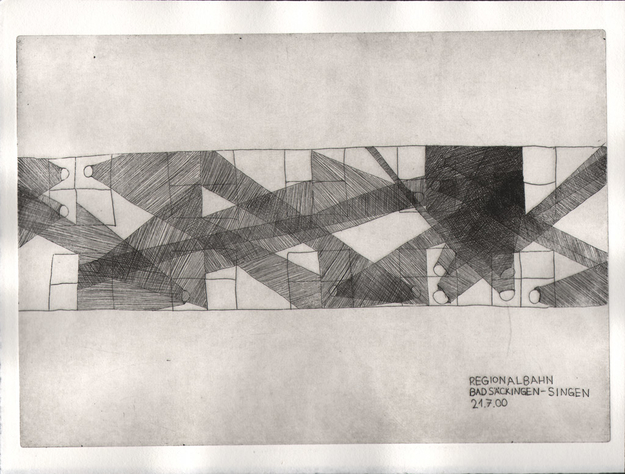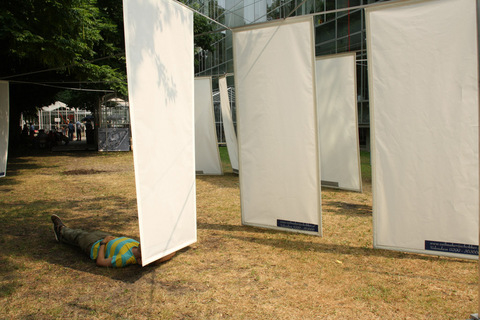Kristin shared that her first panic attack surprised her while she was driving on a highway. “I didn’t know what was going on, couldn’t feel my hands and feet anymore…“ From this point on, she told us, anxiety started to affect many areas of her life, from driving, to taking public transport, to going to restaurants or the hair dresser. She was diagnosed with both agora- and claustrophobia, both intense fears to do with space. Agoraphobia is the fear of open spaces, such as squares or marketplaces. Claustrophobia describes the fear of confined spaces. These phobias cause people to be hyper-aware of the spaces they move around in.
“So when I started studying architectural design at the Rietveld Academy in 2007, I thought that this would be a good topic“, Kristin said.
Her graduation work consists of two parts: a book titled “Architectural Anxiety“, containing her research on the topic as well as personal memories, etchings, and experiments she conducted using herself as a measuring tool and a design for making a public swimming pool in Amsterdam less anxiety-inducing, titled “Shields and Shelter“.
She first guided us through the book, which opens with a powerful and unsettling memory:
Stuttgart, 1998 - there is no single place anymore where I feel safe.
“Where can I hide? How far is it to the door? Is there a possibility to leave the space unobserved? Are there lines of sight? Can I escape? How do I get from one end of the city to the other? These are questions that influence decisions in my daily life.“
“This is a story from the past“, she assured us, “it doesn’t apply to me anymore because I am much better now. But for other people with agoraphobia and claustrophobia this would still be applicable.“
One of the first pages of the book contains a list of fear spaces - cars, airplanes, supermarkets, restaurants, busses, trains, streets - and a rating from 1 to 10 of how much anxiety they cause.
“When I made this chart, I was right in the middle of it, and I couldn’t do anything above a rating of 2, maybe“, she shared. An excerpt from the introduction to the book reads:
“this anxiety limits my freedom. In this thesis I will investigate possibilities of restoring freedom.“
Using herself as a measuring tool, she described and characterised situations in which she suffered from architectural anxiety, and offered practical solutions for architectural safety based on her own fear experiences.
Kristin classified fear spaces, such as urban structures and means of transport, with regard to the functions of the buildings, their characteristics, constructional and interior elements. Social conventions in a space, hiding spaces and lines of sight, niches, dead ends, elevators, lighting and shadow - all these elements play important roles in the experience of a space as safe or unsafe.
History of architectural anxiety
“I believe that partly my issues come from modernity, as weird as that sounds“, Kristin told us. Modern life comes with fast travel across long distances, sound-and air-sealed vehicles, as well as modern architecture with large squares and streets and a lot of glass surfaces, all conditions which can evoke anxiety.
Kristin shared her research: The first cases of agoraphobia were identified by a psychologist in 1871 - “recently a unique nervous disorder has been diagnosed: agoraphobia! Numerous people are said to suffer from it, always experiencing a certain anxiety or discomfort whenever they have to walk across a vast empty place.“
Immediately, this “nervous disorder“ was connected to modernity and urban life, and recognised as a natural reaction to it. “One naturally feels very cozy in small, old plazas.“, writes the Viennese architect Camillo Sitte in 1899, “In our modern gigantic plazas with their yawning emptiness, the inhabitants of snuck old houses suffer attacks of this fashionable agoraphobia. The universal trend of the time is the fear of open spaces.“
Agoraphobia, then, is the fear of open space, specifically squares or other large empty areas in cities. Agora, after all, comes from Greek “market place“. “It’s worse when there are many people“, Kristin explained.
Claustrophobia was first diagnosed not much later, in 1879. “To the fear of empty and open space was added that of crowded and populated spaces, the fear of being enclosed.“ A young soldier suffered from “a panicked fear of being alone in a closed space, sensation of being in a passage getting narrower and narrower to the point of being able to move neither forward nor backward“.
Airplane tunnel - Image from Kristin Maurer's book “Architectural Anxiety“
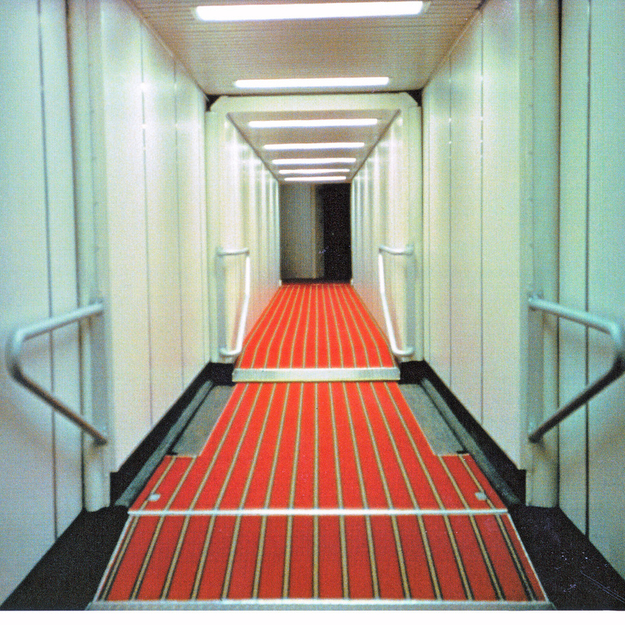
We wondered why these anxiety disorders only surfaced this late in human history, when humans have been dealing with both confined and vast open spaces for thousands of years - think for example of narrow caves or large empty fields. Kristin shared that generally, nature evokes a lot less fear than cities do, although she did not research much further into why this is.
What she did find out was that these fears do not only influence modern Western society, but also manifest themselves in the architecture of other societies such as ancient Egypt. She cites art historian Wilhelm Worringer, who stated that Egyptians added columns to their building which fulfil no other function than breaking up the impression of empty, open space and giving the helpless eye something to hold on to.
Conflicting fears
Something that came up a few times during Kristin’s presentation was the distinction between collective fears and personal fears, two different phenomena which are often at odds with each other when it comes to architectural planning.
Modern architecture is designed to reduce collective fears, by providing transparency, often in the form of glass surfaces and minimalism, but also due to technical features like street lights and security cameras. “Architects and urban planners assume that anxiety can thus be “planned away““, Kristin quoted from her book, and further “the geography of fear correlates directly with the geography of crime“.
This, however, is not true for personal fears such as agora- and claustrophobia. Often, attempts to “plan away“ collective fears result in increased personal fear, as open and transparent spaces offer no places to hide in or escape from view. For one person, the image of dimly lit, narrow and winding alleyways with niches and dead ends evokes fear, since it is connected to a mental image of danger and crime. For another person, it could feel very safe, since there are many opportunities to hide from other people’s gaze and offers privacy and freedom in that way.
It is important to find a balance between the two, Kristin concluded. “Planning away“ collective fear spaces will inevitably spark more personal fear spaces and vice versa, so it is impossible to plan a city free of all architectural anxiety. And that should not be the goal, either, Kristin told us: “Fear is also activity and power. When I am anxious - not too much, not to the point of paralysis, but just a little - it also moves me to do things I wouldn’t otherwise do, it sparks a lot of creativity.“
Churches as escape spaces
One of the only escape spaces in the city, Kristin shared, are churches. “There are many of them, they are usually really beautiful inside and nobody bothers you there“, she explained.
“On the one hand it’s strange that you would need a church for that, but on the other hand it’s beautiful that churches provide shelter, also for refugees, for anybody really!“ Old churches have all of the features that are often missing from modern architecture: niches, columns, benches…
Churches are an in-between space, public but usually largely empty, and quiet by nature of the social conventions that apply. “I was breastfeeding my daughter a lot in churches“, Kristin shared.
Being both largely empty and designed to have columns and corners where it is possible to escape from other people’s sight, churches can potentially feel like safe spaces for both agoraphobic and claustrophobic people. Only, however, if the social code of conduct of respect and quiet is observed as well, and the person has a subjective positive association if churches as spaces of rest and comfort. Personal memory, we realised, also has a strong influence on fear, and churches are of course culturally charged and contain imagery that could be unsettling to many people, too.
Traveling inside a box
“Transport was a big thing for me, because I wasn’t able to take the train for years“, Kristin remembered. In order to overcome her anxiety, she conducted a number of creative experiments with herself on public transport and in other fear spaces such as elevators.
For example, she built a large cardboard box, took the box with her on the train, and then sat inside the box for the duration of the journey.
Kristin traveling inside a box -
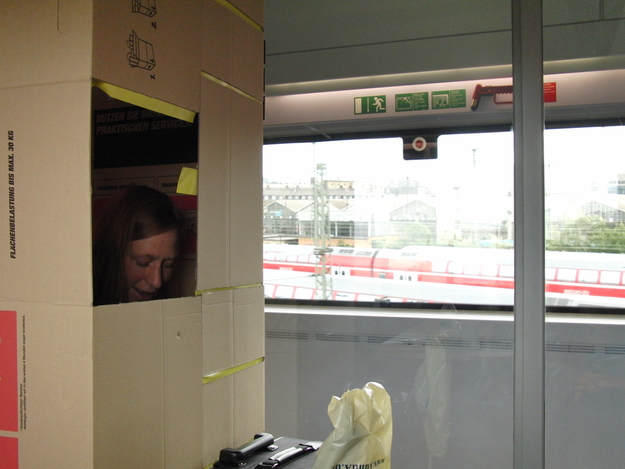
She showed us a video of this, we see the box taking up a lot of space in the train, and hear Kristin’s disembodied voice from inside it. People entering the train look at the box a bit strangely before moving on unbothered. It becomes clear that, in exploring and confronting her fear of spaces, Kristin was not shy to disrupt social norms.
For another experiment, Kristin set up a small tent inside a compartment in a more old-fashioned train. “I just tried various things to create more privacy inside the train“, she explained.
“Were you less scared when you were sitting inside the box?“, another artist asked. “Yes“, Kristin replied, “but of course that was also scary in a different way.“
“I’d be scared that people would call the police on me if I did something like that“, another artist said, to which Kristin replied: “I was more scared of the people looking at me than of the police“.
For another experiment, Kristin set up her box inside of an elevator at the Stedelijk Museum in Amsterdam. We watch a five minute clip of various people entering the elevator while she sits in the box, shielded from view. “The elevator is a classic fear space“, she explained to us. By assuming an observer role inside of this space, instead of being observed, it helps to feel control in a situation where you are normally momentarily out of control.
“Don’t you think you violated the privacy of those people you were filming?“, another artist asked.
Kristin replied: “I was asked that question a lot, and the answer is yes, definitely. When I look back at it now I think 'oh no, what was I doing'…But I have had so much anxiety for so many years and felt so looked at all the time, that it kind of felt like it was my turn, you know?“
Cars and driving
The last limiting fear Kristin still struggles with today is driving a car on a highway. On the highway, it is not always possible to stop, especially when there are construction sites with no emergency lane which you can not see coming beforehand. “One of my symptoms is that I can not feel my hands and feet, which is really dangerous when you’re in a car“, Kristin explained. “But it’s something I need to work on, it limits my freedom.“ Driving in the city, where there is always an opportunity to stop the car, is not a problem for her anymore. “And I believe that in this life, I will be able to drive on the highway again, too!“
Fear space - Driving inside a tunnel - Image from Kristin Maurer's book “Architectural Anxiety“
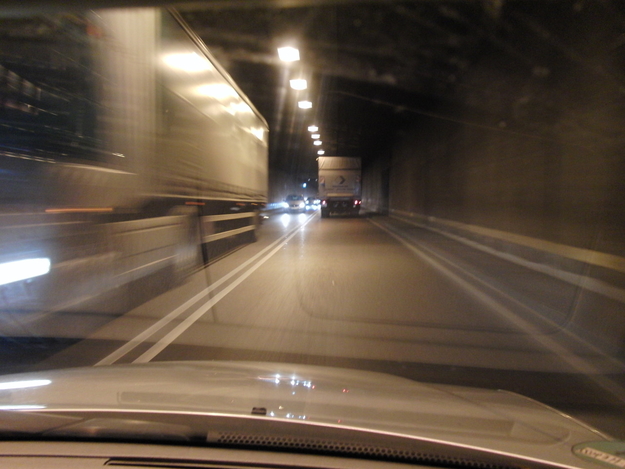
Isn’t autism and driving also a thing?, someone asked, and we discussed whether or not the autistic people among us have issues with driving cars. Someone shared that they can get overstimulated while driving, which results in weird decisions on the road. Someone else told us that he was never able to get his driver’s license, because he constantly got distracted by other things such as clouds or architecture. Of course, these difficulties don’t apply to all autistic people.
The restaurant trap
Another type of fear space on Kristin’s list is the restaurant. She drew our attention to the fact that once you enter a restaurant and sit down at a table, for the next couple of hours you are completely trapped by social conventions and obligations. You have to wait for someone to come to your table, order drinks, wait again, order food, wait again, eat the food, wait again, pay for the food. The waiting times can be quite long, and it is not possible to leave before paying, or even to leave before eating once the food has been ordered. “All of that caused so much anxiety for me that I couldn’t go to restaurants anymore, for years!“, Kristin told us.
This example clearly shows that anxiety has to do as much with the architecture and design of a space as it does with the social conventions and rituals of the space.
Working at Mediamatic
Kristin started working at Mediamatic when she still suffered from extreme anxiety. But Mediamatic was almost never a fear space for her, she told us. The reason for this is the creative chaos which characterises the Mediamatic office: “free sight, mid-level noise, I can do what I want, nothing stands out because everyone is occupied with something. Creative chaos creates a good atmosphere. There are more important things to do than just watching other people.“
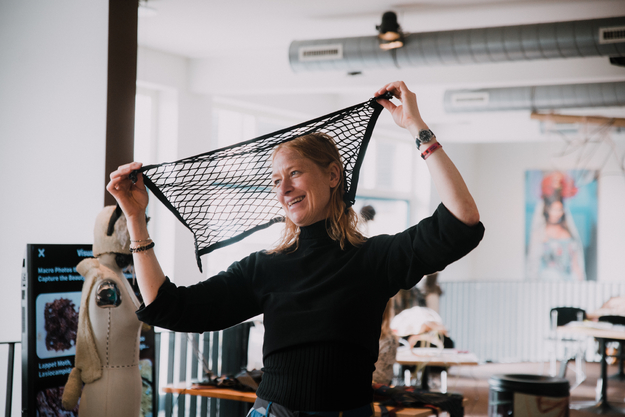
Navigating discomfort
Another question that came up was about tolerance for discomfort. Kristin told us that, for example, when there is a bad smell in a train she will still move around the train trying to find a better spot. Why doesn’t everyone do that? Why do most people just endure discomfort?
Of course, everyone’s filters for sound, smell and other stimuli are different, some people being much more sensitive than others.
“I think it would be groundbreaking if we could live using someone else’s senses for a little while“, one of the artists commented. “It must be crazy to experience.“
Lines of Sight
A lot of the fears Kristin described have to do with the feeling of constantly being observed, looked at, by other people. Being hypersensitive to other people’s gaze, Kristin started mapping lines of sight in the public spaces she occupied, such as trains and busses. She explained: “I tried to find out which were the most exposed places in the train were. Where the most lines of sight overlap, the darkest areas, those were the places I couldn’t go“.
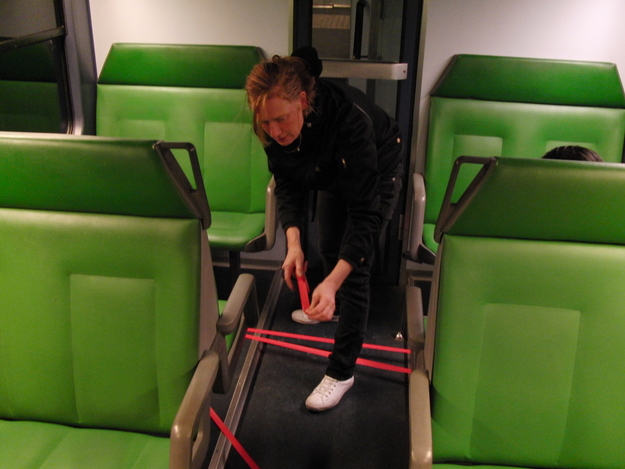
The only solution to this problem, Kristin remembered, was to try to avoid lines of sight, for example by changing seats when new people entered the train.
“I had years of having to step out of trains when they got too crowded“, she told us, “and I had to travel from Amsterdam to Delft every day to get to class, a nightmare!“
Her experiences were echoed in the work of architect Hermann Hertzberger, whom she cites: “we must keep looking for the right balance between view and shielding. That is to say, for the spatial organisation that facilitates anyone to occupy any desired position in relation to others in any situation. With this you can regulate the desired contact in any given situation in such a manner that on the one hand privacy is protected if so desired while the view on the other hand is not limited too much.“
Shields and Shelter
The right balance between view and shielding is exactly what Kristin aimed for with her graduation work “Shields and Shelter“, a 1:1 model for an intervention at the Flevoparkbad, a public outdoor swimming pool in Amsterdam.
She explained that she started with a google maps image of the space, again deducing lines of sight, which she mapped in the form of a drawing, so that the darker areas of the drawing signified points of highest exposure. These dark areas are the places where intervention is necessary, lines of sight should be blocked, she explained. To this end, she created a set-up of moveable “sails“, which allow visitors to create different kinds of spaces which can shield them from view as much as they desire and provide shelter from the sun as well. With these sails, you can also create a small enclosed triangle space, which could function as a changing room. The design is flexible, so that it can be adapted to the needs of a diverse set of visitors.
While the design was not realised at the actual swimming pool, the 1:1 model was displayed on the field behind the Rietveld Academy building as part of the graduation show. However, Kristin has not revisited it much since then - “In the last 12 years I just had no time!“.
Is sensitivity a power?
Kristin told us that although she hasn’t worked on this topic for twelve years now, it is still relevant and interesting to her. Her sensitivity for the layout and design of spaces with regards to lines of sight and hiding spaces is still intact. “That’s a power, do you realise that? You can walk through a building and feel what should be different.“, one of the other artists remarked. “I don’t know about that“, Kristin replied. “It also just costs a lot of energy and time.“
Another question is whether this sensitivity could actually lead to universal improvements to spaces. Is it universal?, to which responded: “I don’t know, you tell me!“
We discussed this and came to the conclusion that everybody’s needs and preferences for spaces are, of course, different. Some people prefer quiet and solitary working environments while others thrive in the midst of creative chaos. There are philosophies about organising spaces, for example Feng Shui, which work for most people, but someone pointed out that neurodiversity is precisely about not being average. What Kristin is describing in her account of architectural anxiety falls outside the norm of how the average person perceives spaces, and her improvements would not necessarily make everyone to feel better. However, “everyone“ doesn’t exist in the first place, and the real challenge is to design for diversity, to provide options: for people who want to be alone, together, shielded, in sight.
“What kind of workspace do you prefer?“ should be a standard question for job interviews!, many of us agreed.
“Is our hypersensitivity to certain input valuable for neurotypical people, too? Or should we insist that these rules are followed in 10 percent of the space, because other people will actually feel limited by it?“, someone asked, and we agreed that this is an important question to explore.
How to survive
Finally, we were all impressed with Kristin’s approach to overcoming her anxiety, as well as her willingness to share her personal story with us like this.
“It’s so much better now, it’s unbelievable“, Kristin said. “Reading all this again, I felt a lot of compassion for myself, all these years that I dealt with all this anxiety, it’s kind of a wonder I survived it like this!“
She shared that what helped her survive were her three young children. “When you have to care for a child, it relativises your own worries“, she explained.
In the end, Kristin was able to not only overcome almost all of her fears, but also to translate them into meaningful research and work that could help improve public spaces for a lot of people.
It also helped us to think about architecture in a different way and made us reflect about the value of hypersensitivity for designing (public) spaces.
Sources
Kristin's book is available here: https://www.amazon.com/Architectural-anxiety-Kristin-Maurer/dp/0557358981
